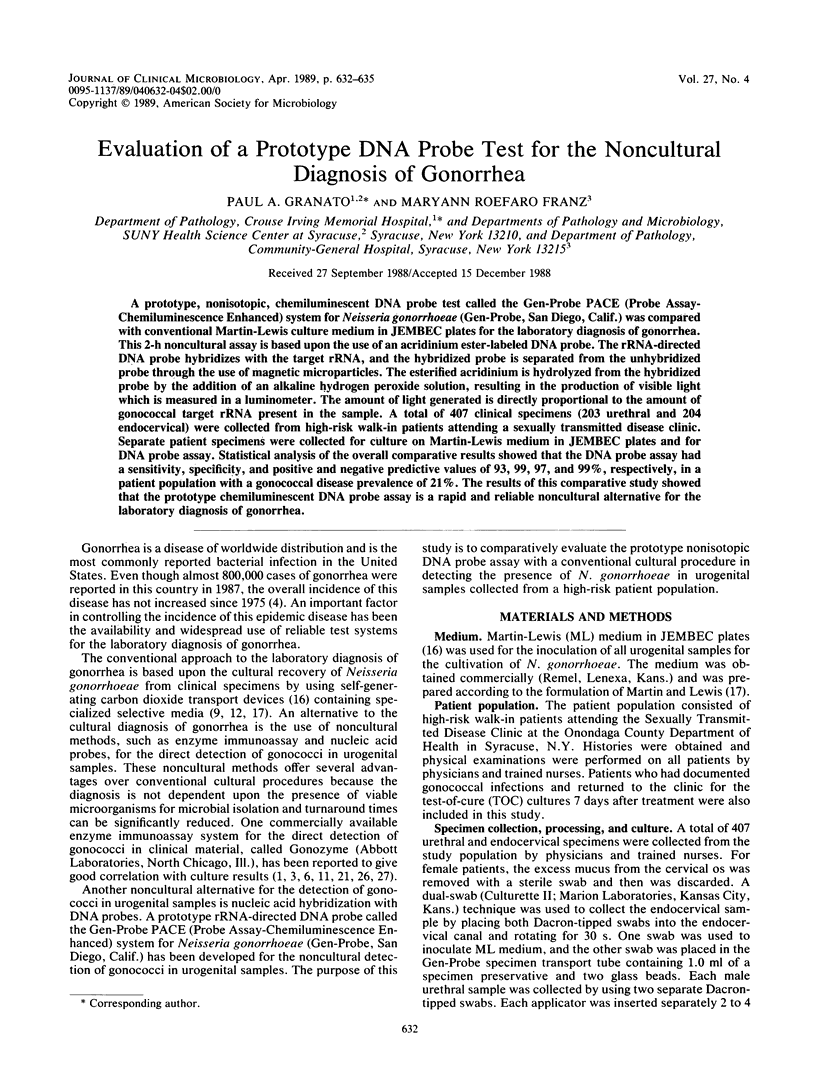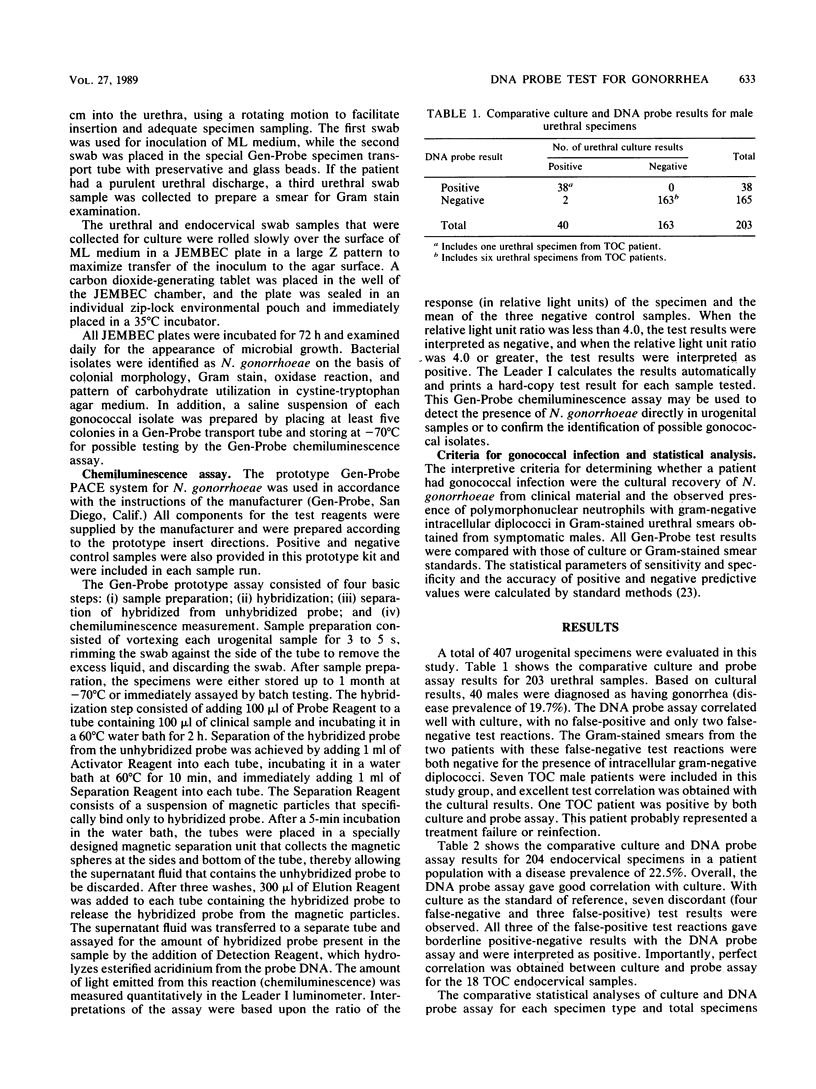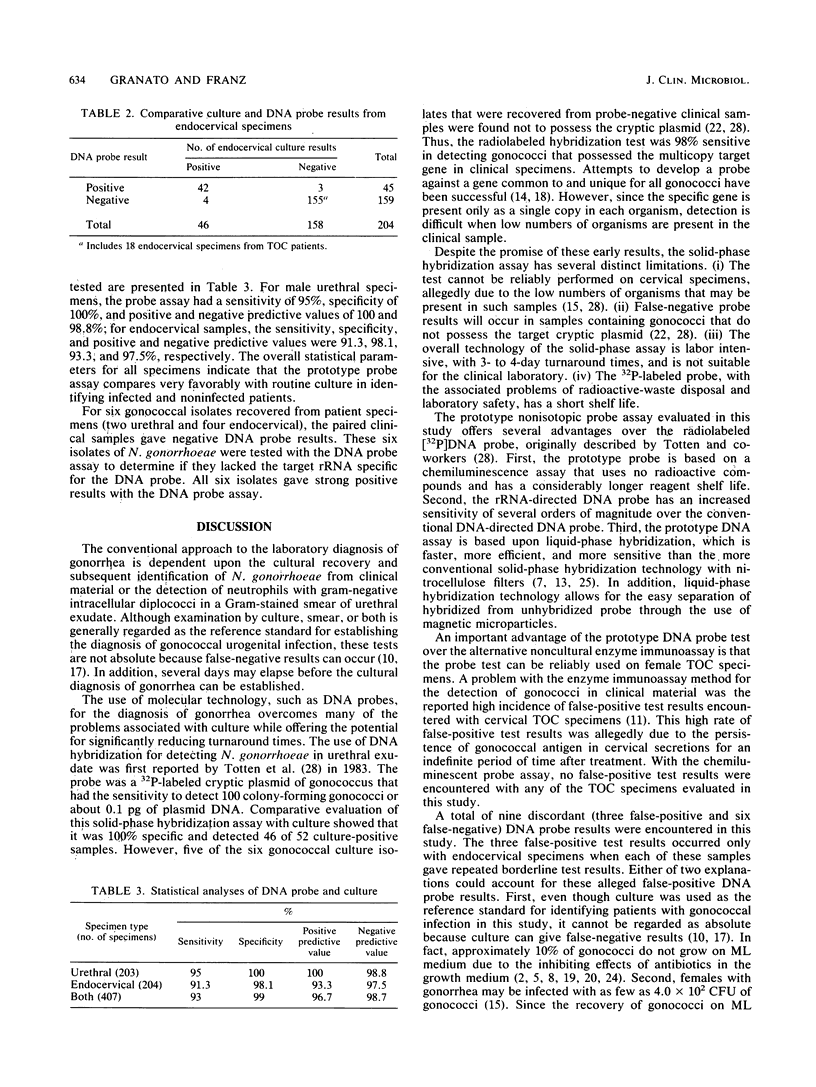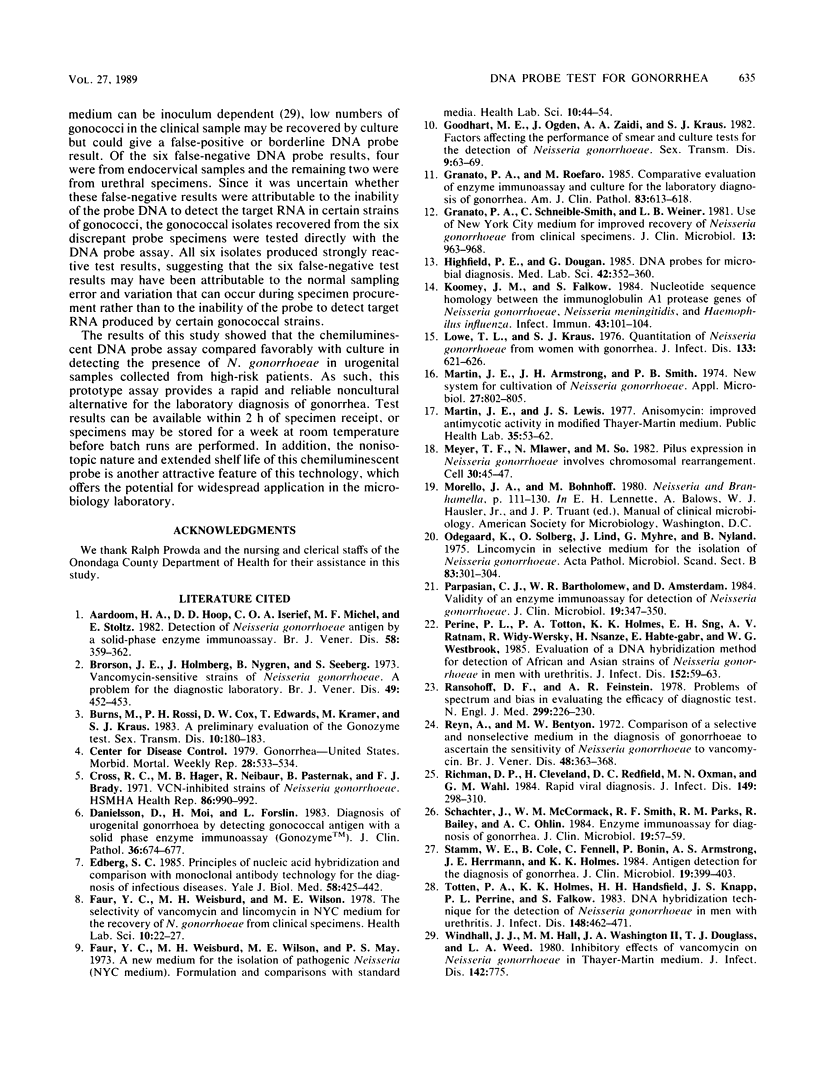Abstract
A prototype, nonisotopic, chemiluminescent DNA probe test called the Gen-Probe PACE (Probe Assay-Chemiluminescence Enhanced) system for Neisseria gonorrhoeae (Gen-Probe, San Diego, Calif.) was compared with conventional Martin-Lewis culture medium in JEMBEC plates for the laboratory diagnosis of gonorrhea. This 2-h noncultural assay is based upon the use of an acridinium ester-labeled DNA probe. The rRNA-directed DNA probe hybridizes with the target rRNA, and the hybridized probe is separated from the unhybridized probe through the use of magnetic microparticles. The esterified acridinium is hydrolyzed from the hybridized probe by the addition of an alkaline hydrogen peroxide solution, resulting in the production of visible light which is measured in a luminometer. The amount of light generated is directly proportional to the amount of gonococcal target rRNA present in the sample. A total of 407 clinical specimens (203 urethral and 204 endocervical) were collected from high-risk walk-in patients attending a sexually transmitted disease clinic. Separate patient specimens were collected for culture on Martin-Lewis medium in JEMBEC plates and for DNA probe assay. Statistical analysis of the overall comparative results showed that the DNA probe assay had a sensitivity, specificity, and positive and negative predictive values of 93, 99, 97, and 99%, respectively, in a patient population with a gonococcal disease prevalence of 21%. The results of this comparative study showed that the prototype chemiluminescent DNA probe assay is a rapid and reliable noncultural alternative for the laboratory diagnosis of gonorrhea.
Full text
PDF



Selected References
These references are in PubMed. This may not be the complete list of references from this article.
- Aardoom H. A., de Hoop D., Iserief C. O., Michel M. F., Stolz E. Detection of Neisseria gonorrhoeae antigen by a solid-phase enzyme immunoassay. Br J Vener Dis. 1982 Dec;58(6):359–362. doi: 10.1136/sti.58.6.359. [DOI] [PMC free article] [PubMed] [Google Scholar]
- Brorson J. E., Holmberg I., Nygren B., Seeberg S. Vancomycin-sensitive strains of Neisseria gonorrhoeae. A problem for the diagnostic laboratory. Br J Vener Dis. 1973 Oct;49(5):452–453. doi: 10.1136/sti.49.5.452. [DOI] [PMC free article] [PubMed] [Google Scholar]
- Burns M., Rossi P. H., Cox D. W., Edwards T., Kramer M., Kraus S. J. A preliminary evaluation of the Gonozyme test. Sex Transm Dis. 1983 Oct-Dec;10(4):180–183. doi: 10.1097/00007435-198311000-00003. [DOI] [PubMed] [Google Scholar]
- Cross R. C., Hoger M. B., Neibaur R., Pasternack B., Brady F. J. VCN--inhibited strains of Neisseria gonorrhoeae. HSMHA Health Rep. 1971 Nov;86(11):990–992. [PMC free article] [PubMed] [Google Scholar]
- Danielsson D., Moi H., Forslin L. Diagnosis of urogenital gonorrhoea by detecting gonococcal antigen with a solid phase enzyme immunoassay (Gonozyme). J Clin Pathol. 1983 Jun;36(6):674–677. doi: 10.1136/jcp.36.6.674. [DOI] [PMC free article] [PubMed] [Google Scholar]
- Edberg S. C. Principles of nucleic acid hybridization and comparison with monoclonal antibody technology for the diagnosis of infectious diseases. Yale J Biol Med. 1985 Sep-Oct;58(5):425–442. [PMC free article] [PubMed] [Google Scholar]
- Faur Y. C., Weisburd M. H., Wilson M. E., May P. S. A new medium for the isolation of pathogenic Neisseria (NYC medium). I. Formulation and comparisons with standard media. Health Lab Sci. 1973 Apr;10(2):44–54. [PubMed] [Google Scholar]
- Faur Y. C., Weisburd M. H., Wilson M. E. The selectivity of vancomycin and lincomycin in NYC medium for the recovery of N. gonorrhoeae from clinical specimens. Health Lab Sci. 1978 Jan;15(1):22–27. [PubMed] [Google Scholar]
- Goodhart M. E., Ogden J., Zaidi A. A., Kraus S. J. Factors affecting the performance of smear and culture tests for the detection of Neisseria gonorrhoeae. Sex Transm Dis. 1982 Apr-Jun;9(2):63–69. doi: 10.1097/00007435-198204000-00002. [DOI] [PubMed] [Google Scholar]
- Granato P. A., Roefaro M. Comparative evaluation of enzyme immunoassay and culture for the laboratory diagnosis of gonorrhea. Am J Clin Pathol. 1985 May;83(5):613–618. doi: 10.1093/ajcp/83.5.613. [DOI] [PubMed] [Google Scholar]
- Granato P. A., Schneible-Smith C., Weiner L. B. Use of New York City medium for improved recovery of Neisseria gonorrhoeae from clinical specimens. J Clin Microbiol. 1981 May;13(5):963–968. doi: 10.1128/jcm.13.5.963-968.1981. [DOI] [PMC free article] [PubMed] [Google Scholar]
- Highfield P. E., Dougan G. DNA probes for microbial diagnosis. Med Lab Sci. 1985 Oct;42(4):352–360. [PubMed] [Google Scholar]
- Koomey J. M., Falkow S. Nucleotide sequence homology between the immunoglobulin A1 protease genes of Neisseria gonorrhoeae, Neisseria meningitidis, and Haemophilus influenzae. Infect Immun. 1984 Jan;43(1):101–107. doi: 10.1128/iai.43.1.101-107.1984. [DOI] [PMC free article] [PubMed] [Google Scholar]
- Lowe T. L., Kraus S. J. Quantitation of Neisseria gonorrhoeae from women with gonorrhea. J Infect Dis. 1976 Jun;133(6):621–626. doi: 10.1093/infdis/133.6.621. [DOI] [PubMed] [Google Scholar]
- Martin J. E., Armstrong J. H., Smith P. B. New system for cultivation of Neisseria gonorrhoeae. Appl Microbiol. 1974 Apr;27(4):802–805. doi: 10.1128/am.27.4.802-805.1974. [DOI] [PMC free article] [PubMed] [Google Scholar]
- Meyer T. F., Mlawer N., So M. Pilus expression in Neisseria gonorrhoeae involves chromosomal rearrangement. Cell. 1982 Aug;30(1):45–52. doi: 10.1016/0092-8674(82)90010-1. [DOI] [PubMed] [Google Scholar]
- Odegaard K., Solberg O., Lind J., Myhre G., Nyland B. Lincomycin in selective medium for the isolation of Neisseria gonorrhoeae. Acta Pathol Microbiol Scand B. 1975 Jun;83(3):301–304. doi: 10.1111/j.1699-0463.1975.tb00106.x. [DOI] [PubMed] [Google Scholar]
- Papasian C. J., Bartholomew W. R., Amsterdam D. Validity of an enzyme immunoassay for detection of Neisseria gonorrhoeae antigens. J Clin Microbiol. 1984 Mar;19(3):347–350. doi: 10.1128/jcm.19.3.347-350.1984. [DOI] [PMC free article] [PubMed] [Google Scholar]
- Perine P. L., Totten P. A., Holmes K. K., Sng E. H., Ratnam A. V., Widy-Wersky R., Nsanze H., Habte-Gabr E., Westbrook W. G. Evaluation of a DNA-hybridization method for detection of African and Asian strains of Neisseria gonorrhoeae in men with urethritis. J Infect Dis. 1985 Jul;152(1):59–63. doi: 10.1093/infdis/152.1.59. [DOI] [PubMed] [Google Scholar]
- Reyn A., Bentzon M. W. Comparison of a selective and a non-selective medium in the diagnosis of gonorrhoea to ascertain the sensitivity of Neisseria gonorrhoeae to vancomycin. Br J Vener Dis. 1972 Oct;48(5):363–368. doi: 10.1136/sti.48.5.363. [DOI] [PMC free article] [PubMed] [Google Scholar]
- Richman D. D., Cleveland P. H., Redfield D. C., Oxman M. N., Wahl G. M. Rapid viral diagnosis. J Infect Dis. 1984 Mar;149(3):298–310. doi: 10.1093/infdis/149.3.298. [DOI] [PubMed] [Google Scholar]
- Schachter J., McCormack W. M., Smith R. F., Parks R. M., Bailey R., Ohlin A. C. Enzyme immunoassay for diagnosis of gonorrhea. J Clin Microbiol. 1984 Jan;19(1):57–59. doi: 10.1128/jcm.19.1.57-59.1984. [DOI] [PMC free article] [PubMed] [Google Scholar]
- Stamm W. E., Cole B., Fennell C., Bonin P., Armstrong A. S., Herrmann J. E., Holmes K. K. Antigen detection for the diagnosis of gonorrhea. J Clin Microbiol. 1984 Mar;19(3):399–403. doi: 10.1128/jcm.19.3.399-403.1984. [DOI] [PMC free article] [PubMed] [Google Scholar]
- Totten P. A., Holmes K. K., Handsfield H. H., Knapp J. S., Perine P. L., Falkow S. DNA hybridization technique for the detection of Neisseria gonorrhoeae in men with urethritis. J Infect Dis. 1983 Sep;148(3):462–471. doi: 10.1093/infdis/148.3.462. [DOI] [PubMed] [Google Scholar]
- Windall J. J., Hall M. M., Washington J. A., 2nd, Douglass T. J., Weed L. A. Inhibitory effects of vancomycin on Neisseria gonorrhoeae in Thayer-Martin medium. J Infect Dis. 1980 Nov;142(5):775–775. doi: 10.1093/infdis/142.5.775. [DOI] [PubMed] [Google Scholar]


